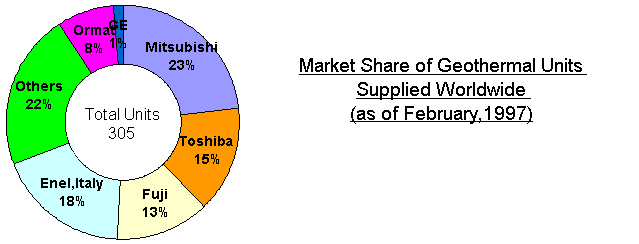
GEOTHERMAL ENERGY FOR POWER GENERATION
Geothermal energy is heat energy from deep inside the earth. Heat is brought near the surface by thermal conduction, by intrusion into earth�s crust of molten magma originating from the mantle and by circulation of groundwater to great depth. Geothermal Energy resources are classified into several basic types. Hydrothermal energy, geopressured energy and magma energy all result from concentration of the earth�s heat in discrete regions of the subsurface by geological processes. Hot dry rock energy occurs at depths of 8 to 6 kms everywhere beneath the surface as a result of the worldwide increase of temperature with depth in the earth. It also occurs at shallow depths in areas of thermal enhancement due to geological processes. Earth energy is thermal energy at normal temperature of the shallow ground, without enhancement due to geological processes. It is found everywhere and can be tapped by geothermal heat pumps.
Today only naturally occurring hot water & steam from hydrothermal sources is being utilised for power generation economically. Exploitation of other types of energy still requires technological advancements for techno-economic viability. Currently over 7000MWe of electricity is generated in 20 countries in addition to 11300MWth of installed worldwide geothermal capacity for direct heating.
Advantages:
Indigenous Energy - helps reduce dependence on imported fuels.
Clean Energy - helps reduce combustion-related emissions from conventional fuels.
Diversity of Use - can be used for electricity generation, heating & ground coupled heat pumps.
Long term Resource Potential - with optimum development strategy, geothermal energy can meet the requirements for 30-50 years.
Flexible System Sizing - geothermal space heating systems range from 30kW to several megawatts. Power generation plants range from 200kW to the largest geothermal power plant of 1200MW at The Geysers in California USA.
Modularity - can be used in simple multiple small easily transportable modules.
Power Plant Longetivity - Geothermal Power Plants are designed for life spans of 20 to 30 years. With proper resource management the life can exceed design values.
High Availability - Availabilities of 95-99% are common for modern geothermal plants compared to 80-85% for conventional plants.
Combined Use - geothermal plants can be used for power generation as well as direct-use applications which results in higher thermal efficiencies and cost savings.
Low O&M Costs - annual O&M costs are typically 5 to 8% of the capital costs which is same as for conventional plants. The current cost of generation from typical geothermal systems range from $0.05-0.08 / kWh which are competitive with conventional sources in some parts of the world.
Commercial Viability
:
For a geothermal energy development project to be commercially viable, the five parameters listed below have to lie within acceptable ranges. These parameters have an overriding effect on initial development costs.
- Temperature � Useful geothermal temperatures ranges from 100C for Geothermal Heat Pumps (GHPs) to more than 3000C for electricity generation. In general, the higher the temperature the better the economics for generating electricity.
- Energy Production Rates � The amount of energy that can be economically extracted from geothermal the fluid�s temperature, flow rate, and the energy conversion technique. The useful output per well can range from a few kilowatts for shallow low-temperature wells to tens of megawatts for deep high-temperature, highly productive wells.
- Utilization Factors � Because of the substantial capital investment in drilling and power conversion, geothermal power plants are best suited for baseload applications which generally provide greater economic returns than applications with low utilization factors, such as peaking plants.
- Well Depth � The deeper a geothermal well, the more it costs. However, wells as deep as 3,000meters can be drilled economically, provided that the energy production rates from the wells are high. Well in use today range in depth from 60 to 3,000 meters.
- Energy Transport � Electricity can be transported over long distances. Thus, a geothermal power plant can serve distant customers. Hot water can be transported over moderate distances (typically 1 to 2km, put up to 50km if the system capacity is very large), depending on resource and end-use temperatures, terrain conditions, and local climatic conditions. Geothermal steam must be used within one to two kilometers of the production wells.
Other variables, including regulatory requirements, finance rates, and environmental constraints, also affect project economics.
The Technology:
Geothermal power plants are divided into the following types depending on the different fluids from wells:
1. Superheated steam type
Dry steam resources are rare but are the simplest and least costly to develop. Naturally occurring steam can be used in a standard steam turbine to generate electricity. The steam produced from geothermal wells is fed directly to the steam turbine using insulated pipelines.
2. Hot water type
Liquid dominated resources are more common. If resource temperatures are fairly high (> 1700C), the liquid can be partially flashed to steam in a tank maintained at a much lower pressure, for use in a steam turbine. If temperatures are moderate (1000C to 1800C), the heat in the liquid can be used to vaporise a secondary organic working fluid, and produce power using a binary cycle plant.
- Single flash cycle � If the geothermal fluid is in a compressed liquid state, it partially flashes into steam in the well-bore as it rises to the surface. Additional steam is separated in the flash tanks and fed to the steam turbine. The remaining liquid is then disposed off on the surface or re-injected back into the reservoir.
- Multi-flash cycle � If resource temperatures are sufficiently high the fluid can be flashed twice or more. Flashing occurs in the well and in the separators on the surface. This separated high-pressure steam is fed to the high-pressure stages of the turbine. The liquid fraction from the first separator is flashed again in a second, low-pressure separator. The additional steam is fed to the low-pressure stages of the turbine. The addition of a second flash stage increases the plant efficiency by about 20% compared to a single flash system.
- Binary cycle � If resource temperatures are low (100 to 1800C), then the hot water is used to boil a working fluid in a heat exchanger, usually some organic compound with a very low boiling point. The vapor produced by heating the organic compound is expanded in the turbine to generate power. After condensation the fluid is recycled through the heat exchanger in a closed cycle. As a closed loop system, binary geothermal power plants produce no air emissions.

Setting up a Geothermal Power Project :
The development of a successful geothermal energy project relies on a variety of specialised technologies. Cost-effective use of each technology is crucial.
- Exploration: The first stage of development of a geothermal plant begins with exploration to find a reservoir at an economically useful temperature & depth with adequate permeability and volume. Exploration relies on surface measurements of subsurface geological, geo-chemical & geophysical conditions. Integration of data from a wide variety of sources to develop a good conceptual model of the system is most important.
- Well Drilling & Testing : Drilling of wells is done to measure subsurface temperatures and flow rates, measure other subsurface conditions and to produce and re-inject the geothermal fluid. After each well is completed production and/or injection tests are run. Reservoir characteristics related to temperature, pressure, chemistry and permeability are measured and used to plan resource utilisation.
- Reservoir Engineering: Information gathered from subsurface measurements and well testing is used to generate and refine a model of how the reservoir works. These models are used to optimise energy extraction and maximise the economic lifetime of the resource. Reservoir engineering determines major design considerations such as location depth flow rate, configuration and number of production & injection wells.
- Power Plant Design: Geothermal Power Plant design depends on the physical characteristics of the geothermal fluid. Ability to accommodate changes in fluid pressure, enthalpy and non-condensible gases content that may take place in later part of the system lifespan is also important. Dry steam power plants at The Geysers field in California have been online since 1960 and have proved to be cost competitive with other generating sources. Single and Dual Flashed Steam Power Plants are widely used in the US & worldwide. Binary technology has been successful using resource temperatures as low as 1000C.
- Fluid Handling : Chemical constituents in some geothermal fluids can cause scaling, corrosion or mechanical erosion of wells, gathering/injection systems and surface plant equipment. Recent research has yielded major advances. Injection of carbonate scale inhibiting compounds into production wells; use of crystalliser-clarifier technology and pH modification to control silica scaling; polymer concrete liners for pipes and CO2 resistant cements for production wells have helped overcome brine handling problems.
- Environmental Control : H2 S emissions to atmosphere, land use and disposal of solid wastes are the hazards to be tackled to meet strict environmental regulations. Although the intensity of these hazards varies from site to site, development of appropriate control technologies has facilitated sound geothermal systems.
WORLDWIDE INSTALLED GEOTHERMAL POWER
|
|
|
Installed Capacity MW e |
Installed Capacity MW thermal |
|
1 |
USA |
2961 |
1874 |
|
2 |
Philippines |
1922 |
0 |
|
3 |
Mexico |
753 |
28 |
|
4 |
Italy |
631.7 |
308 |
|
5 |
New Zealand |
323.8 |
264 |
|
6 |
Japan |
503.705 |
319 |
|
7 |
Indonesia |
587 |
0 |
|
8 |
El Salvador |
105 |
0 |
|
9 |
Nicaragua |
70 |
0 |
|
10 |
Costa Rica |
60 |
0 |
|
11 |
Iceland |
49.4 |
1443 |
|
12 |
Kenya |
45 |
0 |
|
13 |
China |
32 |
2143 |
|
14 |
Turkey |
20.6 |
140 |
|
15 |
Russia |
11 |
210 |
|
16 |
France |
4.2 |
456 |
|
17 |
Portugal |
5 |
|
|
18 |
Romania |
2 |
137 |
|
19 |
Hungary |
|
638 |
|
20 |
Georgia |
|
245 |
|
21 |
Switzerland |
|
110 |
|
22 |
Slovakia |
|
100 |
|
23 |
Tunisia |
|
90 |
|
24 |
Serbia |
|
80 |
|
25 |
Macedonia |
|
70 |
|
26 |
Poland |
|
63 |
|
27 |
Others |
|
329 |
|
TOTAL |
8392 |
9047 |
Geothermal Power Plants: Technology Suppliers
|
|
Technology Supplier |
No. of Units Supplied |
Remarks |
|
1. |
Mitsubishi Heavy Industries, Japan |
71 |
1808.0 MW |
|
2. |
Ormat International, USA |
200 |
550 MW operational |
|
3. |
Fuji Electric, Japan |
|
|
|
4. |
Toshiba, Japan |
|
|
|
5. |
Ansaldo |
|
|
|
6. |
GE |
|
|

Indian Scenario :
A systematic geothermal survey in India began in 1973 undertaken by Geological Survey of India and the existence of 340 potential sites was reported. Eleven geothermally prospective districts have been identified till date. Most of them appear to have resources at temperatures of about 100-1200C, but some appear to have reservoirs at 1-3 km depth with calculated geothermometry temperatures of 200-2500C. The most promising geothermal fields as on date are :
- NW Himalayas: Puga-Chumathang (Ladakh district, J&K) where a 1MWe plant is planned, and Parbati Valley with the Manikaran field in Himachal Pradesh where in 1992 a 5kWe geothermal binary cycle plant was successfully run.
- Central India: Tattapani region (Madhya Pradesh) where the installation of a 20MWe binary plant has been planned.
No deep geothermal well has been drilled to date. Large-scale availability of cheaper energy sources like coal apparently has hampered the growth of geothermal energy exploitation.
Future prospects:
Hydrothermal reservoirs, the only geothermal resource which has been economically utilised for power generation, represents just 10% of the total geothermal resource base. Hot dry rock energy offers enormous potential for power generation. It occurs at relatively water free hot rock fund at various depths beneath the earth surface. The energy can be extracted by circulating water through man-made fractures in the hot rock. However current technology is not commercially viable for extracting hot dry rock energy. Geo-pressured brines are hot, pressurised, methane-rich waters found in sedimentary basins 10,000 to 20,000 feet below the surface. Magma is the molten rock inside earth crust. With advances in technology these resources have the potential to provide limitless energy.
Source:
- Geothermal Energy Association, USA
- Geothermal Power Generation Catalogue by MHI, Japan
- Geothermal Power Plants Catalogue by Ormat, USA

BACK TO MY HOME PAGE | IGCC | CFBC | PFBC | SOLAR THERMAL | WIND POWER | GEOTHERMAL | FUEL CELLS | COALBED METHANE




